Album Weeds – Buenos Aires
The early Buenos Aires stamps are a marvel of ugliness, and most shamefully printed. The fault of the latter peculiarity lies, I fancy, a good deal in the paper, which is much too thick and rough for the lithographic process. In consequence of the badness of the execution, the stamps vary considerably; points of the design, easily seen in one stamp, are totally invisible in another; etc. The 3, 4, and 5 Pesos are very scarce. The denomination of value on some of the stamps is rather puzzling to beginners. The 1 peso is found as IN, and also as TO; and the 4 pesos is labelled CUATO, in mistake for CUATRO. None of them are labelled in figures. Pemberton’s Handbook says that the 4 and 5 pesos had only a six months’ existence, after which they were suppressed, and the CUATO was printed in brown, instead of red; the CINCO, with the value partially erased, and printed in brown and in blue, passed for 1 Peso.
1856. 1 (IN, TO) Peso; blue, brown.
Genuine
Very badly lithographed, on very thick, yellowish-white wove paper. The lettering of CORREOS is very much larger than any of the other lettering on the stamp; and the second O of that word is much larger than any of the other letters. In each corner of the stamp there is a large white dot, more or less round; and each of these dots is usually larger than the last O of CORREOS. The name, BUENOS-AIRES, has a hyphen between the two words. Three of the large white dots, and sometimes all four, touch the line outside them. The sun appears to be about half risen; and there are, normally, about eight long rays proceeding from his upper limb; but it is very seldom that more than four of them are visible. The thick oval line, surrounding the ship, etc., does not go all the way round; it is broken on the left side, and the shape of the oval is continued by the horizontal shading, which represents the sea. The IN is very distinct, and just before it there are the remains of the C. The whole of the C has been erased, except just the very ends or tongues of the letter. In the one labelled TO, only a part of the o can be seen, and sometimes it is reduced to a mere dot. The upper spokes of the paddle-wheel of the steamer are never visible, and the lower ones very rarely. There are seven oblique lines (to represent sail and tackle) between the bowsprit and the mast, several of them being broken and irregular; but usually all of them can be counted. The flag on the mast is composed of two converging lines, with a white space between them; thus looking like two small, dark streamers, with the upper one nearly horizontal, and the lower one sloping upwards towards it. The level of the surface of the sea is higher than the top of the bowsprit, so that two, at least, of the horizontal lines, representing the water, are above the top of it. Quite at the stern of the vessel, opposite to the A of FRANCO, there is a distinct flag, touching, with its outer end, the outline of the central oval.
First Forgery. (IR PS)
Rather nicely lithographed, in very dark blue, on very hard, white wove paper. The value appears as IR Ps ; and the partly-erased C has only had just the back taken out of it, leaving the rounded top and bottom, as well as the tongues. The lettering of CORREOS and of BUENOS AIRES is all small, and there is no hyphen between the latter two words. All the letters of CORREOS are of exactly the same size, and as small as the letters of the name. The white dots in the corners are quite small, and about the same size as the O of CORREOS. None of these dots touch the border. The sun does not show any lower rays, but still, by his height above the steamer, he ought to be quite risen. There are seven short rays proceeding from his upper limb. The tip of the bowsprit crosses his face, instead of being far below him. The thick oval line, surrounding the steamer, etc., goes all the way round, unbroken. The easiest test for this forgery is in the value being IR PS instead of IN Ps. The R is quite distinct, and cannot be mistaken for an N. There are three distinct, white upper spokes to the paddle-wheel. There are nine oblique lines, two of them very faint, between the bowsprit and the mast; and the two outer lines to the left are connected together by a series of short, horizontal lines, so that the whole looks like a ladder, leading from the tip of the bowsprit to the very top of the mast. The flag on the mast is something like the genuine, except that the two streamers are parallel, instead of converging, and the end of each is forked. The end of the bowsprit is far above the level of the surface of the sea. The flag at the stern slopes downwards, towards the N of FRANCO; and its end, which is not outlined, does not touch the outline of the oval.
Second Forgery. (IR PS)
This forgery is found in brown, light green, dark green, rose, yellow, and orange ; but all the colours are labelled alike, IR PS, like the forgery just described, so that no one need be taken in by them. Very badly lithographed, on hard, yellowish-white wove paper. The lettering at the top and bottom is very large and tall, almost reaching to the top and bottom of the containing-labels. The word CORREOS gets gradually larger from the beginning to the middle, and then gradually smaller again from the middle to the end. The white dots in the corners are a good deal smaller than either O of CORREOS, and they do not touch the border anywhere. The rays of the sun are very short, and have been placed so close together, that they have all run into one semicircular blotch. The oval is unbroken all the way round. I think this forgery is more deceptive than the last; but the great size of the lettering of BUENOS AIRES will instantly condemn it. The paddle-wheel shows four large, white upper spokes. There are six oblique lines, not broken, joining the bowsprit and the mast. The outer two form a ladder, as in the first forgery, but the rungs of the ladder are blotched together, so that they form an almost solid mass. The flag on the mast consists of two parallel, dark bars, with a white space between them. The surface of the sea is level with the deck of the vessel; and so the whole of the bowsprit is above the level of the sea, and the tip of it touches the outline of the containing-oval. There are merely some very faint indications of the flag at the stern of the vessel; and the flag does not go near the outline of the containing-oval.
Third Forgery. (IN ps)
Lithographed, in dark, reddish-brown, and also in very pale sky-blue, on medium, smooth, very white wove paper. This is exactly the same as the second forgery, except that the white balls in the corners are very small; and it is labelled IN Ps, with no vestige of the C.
Fourth Forgery. (T. PS)
Lithographed, in sky-blue, on medium, smooth, very white wove paper. This is exactly the same as the second forgery, except that the balls are very small; and it is labelled T. PS, with no vestige of the C.
Fifth Forgery. (IN ps)
Lithographed, in pale, dead blue, on very white wove paper, rather thin, smooth, and hard. The value is correctly written IN PS; but there is hardly any indication of the erased C before it,—just the merest trace. The lettering of CORREOS and of BUENOS AIRES is all of the same size, and all in thin letters. There is no hyphen between the words of name. The white dots in the corners are large, but not so large as in the originals, and none of them touch the boundary. The sun shows four thick, short rays, of equal length. The thick, oval line surrounding the steamer, etc., is unbroken. The easiest test for this forgery is in the fact that the line which runs round the whole stamp, outside everything, is a very thin, straight line; whereas this line, in the genuine, is thick and waved, almost as if it had been intended to imitate a perforation. The final O of FRANCO is very small, and a good deal smaller than the rest of the letters of that word. The spokes on the paddle-wheel are visible, very nearly all round the wheel. There are five oblique lines or ropes, joining the mast and the bowsprit together, and none of them are broken. There is no flag on the mast. The top of the bowsprit is level with the surface of the sea. There is no flag at the stern of the vessel.
This forgery is gummed at the back, and has a very new look; but, at the same time, I think that many collectors might be deceived by it.
Sixth Forgery. (UN PS)
Lithographed, in reddish-brown, on thin, rough, greyish-white wove paper. The value is written UN PS., with no indication of the C. The lettering of CORREOS and BUENOS AIRES is very thin, and there is no hyphen. The white dots are small — smaller than the O of CORREOS— and none of them touch any of the outlines of the frame. As far as I can see, from my very poor specimen, the sun is exceedingly faint, so as to be hardly noticeable. The outline of the central oval is solid all the way round. The dark line, surrounding the whole stamp, is not scalloped inside, though it is a little wavy here and there. The rest of the details are undecipherable in my copy; but of course the UN PS is a fatal error, which will serve as an easy test. I have only seen this forgery lately (1892), but it looks old.
Seventh Forgery. (I PS)
Nicely lithographed, in clear red-brown, on very thick, hard, very white wove paper. This is identical with the first forgery of the Dos pesos, hereafter to be described, but is labelled I PS. The numeral will, of course, condemn it at once.
Eighth Forgery. (IK- PS)
Lithographed, in pale vermilion, on stout, hard, rough, very yellowish white wove paper, showing a curious mottled grain, when held up to the light. The lettering of BUENOS-AIRES is very nearly as large as CORREOS, which latter is as large as the genuine, though the second o of CORREOS is not any larger than the other letters. There is a very distinct, short hyphen between the words. Three of the corner-dots touch the frame, as in the genuine. The sun is closely copied, but the bowsprit reaches to the center of his face. The outline of the central oval is solid all the way round. FRANCO is in thin, tall letters, very unlike the short, somewhat thick letters of the genuine. The value shows the head and tail of the C, a perfect 1, and the N has only the first upright stroke, and the oblique stroke; the second upright stroke being altogether absent. After this mutilated N there is a blurred dot, level with the center of the N. The foot of the P of PS is too long, so that it goes very near the bottom of the containing-label; though, in the genuine, there is a wide white space below the bottom of the (very short) P. The white line, marking the upper half of the paddle-wheel, is perfectly semicircular, whereas it is the half of a transverse oval in the genuine. There are no traces of any spokes. The ropes are as in the genuine; but there is a dark flag, crossing three of the ropes, to the left of the mast, about one-third of the way from the top, which does not exist in the genuine. The tip of the bowsprit is above the level of the sea. The outlined flag, touching the outline of the oval, opposite to the A of FRANCO, leans slightly down to the right, instead of being perfectly horizontal. This forgery looks very new.
Ninth Forgery (UN – Ps)
Lithographed, in pale sky-blue, on very thick, very hard, bluish-white wove paper. The stamp is labelled UN – ps, with a very distinct hyphen between the two words. The S of CORREOS is larger than any other letter in the whole inscription. BUENOS AIRES is too large; and there is a distinct white dot, between the words, level with the top of the S of BUENOS. The corner-dots are as large as in the genuine, but none of them touch the outline of the frame anywhere. The sun is too large, with three long rays, and two short ones. The outline of the central oval is solid all the way round. The paddle-wheel shows seven somewhat wedge-shaped, white lower spokes. (There are only four in the genuine, and they are not wedge-shaped.) There are four ropes, and a very distinct ladder (more distinct than in the second forgery), joining the mast and the bowsprit, but the bowsprit itself is quite invisible. The sea is perfectly calm. The outlined flag, opposite the A of FRANCO, slopes down very much to the right, instead of being perfectly horizontal. The S of AIRES is high above the level of the other letters.
Postmarks
Genuine.—A diamond, of small, diamond-shaped, or round dots, with a curious fringe of lines, along each side of the diamond.
First Forgery.—A portion of I, very large, also some unreadable letters.
Second Forgery.—A portion of an oval cancellation, something like 27, generally struck in blue. Also 76.
Third Forgery.—Same as last.
Fourth Forgery.—Uncancelled.
Fifth Forgery.—Uncancelled.
Sixth Forgery.—An imitation of the fringed diamond of the genuine.
Seventh Forgery.—1. Also uncancelled.
Eighth Forgery.—Uncancelled.
Ninth Forgery.—1.
Besides these, I have seen 6, without numerals; 29, 42, without numerals; one somewhat like 85; 100 and 101; but did not note the particular forgeries on which they were found.
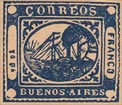 1856. 2 (DOS) Pesos, blue.
1856. 2 (DOS) Pesos, blue.
Genuine
Lithographed, in a lighter blue than that of the blue 1 peso. The paper, design, etc., are the same as in the 1 peso, except that the value appears as DOS PS., in small block letters, not nearly filling up (either in width or height) the label containing them.
First Forgery. (2 PS)
Lithographed, in sky-blue, on thick, hard, smooth, very white wove paper. The lettering of CORREOS is much smaller than that of BUENOS AIRES. The white dots in the corners are small, but larger than the O of CORREOS. There is no hyphen in the name. (By the way, I ought to have stated that the hyphen, in the genuine, generally looks more like a small white dot than anything else.) None of the corner-dots go any- where near either inner or outer outlines of the frame. The half sun is high above the water, and the bowsprit and one of the ropes pass right across its face, which shows ten short rays. The outline of the oval is solid all the way round, and the left side of the sea does not touch it. There are five or six white, upper spokes visible in the paddle-wheel; 11ill six ropes pass obliquely from the bowsprit to the mast, touching both. The value is written 2 Ps which will, of course, instantly condemn this forgery, without need of further description.
Second Forgery. (DOS PS)
Lithographed, in brilliant, dark blue, on rather thick, smooth, bluish- white wove paper. This is the same as the second forgery of the 1 peso, except that it is labelled DOS PS., in large block letters, almost entirely filling up the height and width of the containing label.
Third Forgery. (DOS – ps)
Lithographed, in pale sky-blue, on thick, hard, bluish-white wove paper. This is the same as the ninth forgery of the I peso, with the exception of THE points now to be described. The stamp is labelled DOS-PS., with a large hyphen between the words. There is no dot or hyphen between the words BUENOS AIRES, and the S of the latter word is not out of place.
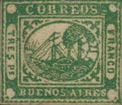 1856. 3 (TRES) Pesos, green.
1856. 3 (TRES) Pesos, green.
Genuine
Lithographed, in yellow-green, on thick, very yellowish-white wove paper, sometimes rather shiny and greasy-looking on the face. The tests are the same as for the genuine 1 peso, except that it is labelled TRES PS.
First Forgery. (3 PS)
Lithographed, in bluish-green, on rather thick, hard, greyish-white wove paper. This is identical with the first forgery of the 2 pesos, but is labelled 3 PS.
Second Forgery. (TRES ps)
Lithographed, in dark yellow-green, on medium, white wove paper. The lettering of CORREOS is hardly any larger than that of BUENOS AIRES. The top-stroke of the E of CORREOS is absurdly prolonged, to double its proper length. The letters of all the three words are very thin and ragged; BUENOS AIRES being almost unreadable. There is no hyphen. The corner-dots are small, and none of them touch any portion of the frame. I can make out six rays to the sun, very short and faint; but my copy does not show the sun itself. The outline of the central oval is solid all the way round. The value is correctly labelled TRES PS., but the block letters are too thin. The paddle-wheel is obscured by the postmark, in my specimen, but I can see indications of some white, upper spokes. There seem to be six ropes, joining the bowsprit and the mast, two only of them touching both. One very small streamer can be seen on the mast. There are two yards, crossing the mast obliquely, which are not seen in the genuine. In a perfect copy, the sea would come about level with the tip of the bowsprit. The flag at the stern not only touches the outline of the central oval, but trespasses very slightly beyond it to the right. The thin letters of CORREOS and BUENOS AIRES will serve, I think, as easy tests. The description given here does not sound so very different from that of the genuine, but the appearance of the stamp, as a whole, is bad.
1856. 4 (CUATO) Pesos, red, brown.
Genuine
Lithographed; paper, etc., as before. The tests are the same as for the genuine 1 peso, except that the stamp is labelled CUATO PS.
First Forgery. (4 PS)
Lithographed, in pinkish-vermilion, and also in cold brown, on stout, very white wove paper. This is identical with the first forgery of the 2 pesos, except that it is labelled 4 P-J, with a stop under the little S.
Second Forgery. (CUATRO PS.)
Lithographed, in carmine-vermilion, on stout, greyish-white wove paper. This is the same as the first forgery of the 3 pesos, but is labelled CUATRO PS.
Third Forgery. (CUATR PS.)
Lithographed, in pale pink, on medium, hard, white wove paper. This is the same as the second forgery of the 1 peso, but is labelled CUATR ps.
Fourth Forgery. (FOUR PS)!
Lithographed, in warm brown, and also in vermilion, on stout, moderately hard, very yellowish-white wove paper. In general appearance, this stamp is very like the first forgery of the 2 pesos. The lettering of CORREOS is about the same size as that of BUENOS AIRES; there is no hyphen, and the N of BUENOS is reversed, i.e., the oblique stroke runs down from right to left, instead of from left to right. The corner-dots are small, and do not touch the outlines of the frame anywhere. The sun shows six short rays. The bowsprit crosses his face, and touches the outline of the oval, which is solid all the way round. There are three very distinct, white upper spokes to the paddle-wheel, but the whole of the lower half of it is buried in the water. The flag on the mast is formed by two parallel, dark streamers, with fringed ends. The bowsprit comes above the level of the sea. At the stern of the vessel there is a larch-tree, leaning over to the right. The stamp is labelled FOUR PS-
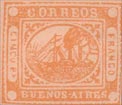 1856. 5 (CINCO) Pesos, orange.
1856. 5 (CINCO) Pesos, orange.
Genuine
Lithographed; paper, etc., as in the genuine 1 peso, but labelled CINCO PS.
First Forgery. (5 PS)
Lithographed, in dull, dark, chocolate-brown, and also in bright blue, on medium, greyish-white wove paper. This is identical with the first forgery of the 2 pesos, but is labelled 5 ps.
Second Forgery. (CINCO PS.)
Lithographed, in dark, ochre-yellow, on rather thin, hard, bluish-white or greyish-white wove paper. This is the same as the first forgery of the 3 pesos, but is labelled CINCO PS.
Third Forgery. (CINCO PS.)
Lithographed, in greenish-yellow, on rough, yellowish-white wove paper, very thick and hard. The lettering of CORREOS is hardly any larger than that of BUENOS AIRES. There is no hyphen. The corner dots are rather small, and none of them touch any of the outlines of the frame. The sun shows about ten rays; and they are vertical, instead radiating; which is an easy test. The tip of the bowsprit reaches to the very center of the sun’s face, and is high above the level of the water. The outline of the central oval is solid all the way round. The stamp is correctly labelled, CINCO PS. There are three lower white spokes to the paddle-wheel, and they are placed almost vertically, instead of radiating. I here are six ropes between the bowsprit and the mast, and one of them only goes half-way across. The top of the mast is covered by the postmark, in my specimen. The sea is very calm, with no sign of any white waves, though it boils furiously, in the genuine, about the front part of the vessel, and near the paddle-wheel.
Fourth Forgery. (CINCO PS.)
Lithographed, in yellow-brown or cold bistre, on medium, greyish-white wove paper. The lettering is very like that of the genuine, except that BUENOS AIRES is too small. There is a small hyphen. The dots in the left upper and right lower corners are very small, and do not touch the frame; the other two dots are much larger, and both touch the frame.
The sun shows seven long rays, and there are three horizontal, dark bars across his face. The outline of the oval is broken on the left side; its shape being continued, as in the genuine, by the horizontal shading, which represents the sea. The stamp is correctly labelled, CINCO PS. There do not seem to be any spokes to the paddle-wheel. There are, as in the genuine, seven lines between the bowsprit and the mast; one of them does not go all the way across. The lower part of the said mast is composed of two thick, parallel dark lines, with a white space between them. (In the genuine, the two dark lines diverge at the bottom, and get nearer together at the top.) The flag at the stern of the vessel, near the A of FRANCO, is widest where it touches the outline of the oval, though, in the genuine, the top and bottom sides are perfectly parallel, so that it is the same width throughout its length. The S of AIRES is at a good distance from the white dot to right of it: in the genuine, they very nearly touch each other.
Concerning the genuine stamps, I may add that, besides the varieties mentioned by Mr. Pemberton, I have seen the 1 peso labelled 1 PESO. It is from the matrix of the CUATO PS.; and the T of CUATO has had the lop cut off, and the O altogether erased, leaving the upright stroke of the mutilated “T” to do duty as a “1.” I do not remember seeing more than one specimen of this, so it is probably not common. Of the altered stamps, however, there are 48 varieties to be found, in consequence of the careless way in which the alterations were made.
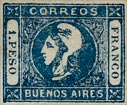 1860. Paris Print. 4 Reales, 1 & 2 Pesos.
1860. Paris Print. 4 Reales, 1 & 2 Pesos.
The first issue of the set with head of Liberty was printed in Paris. The stamps are not marvels of execution, but they are infinitely clearer and better in every way than the later ones, printed in the Republic itself. Indeed, I fancy that some of the latter would be rejected by our younger brethren, as counterfeits, though they must yield the palm of ugliness to the first issue.
Genuine
Clearly lithographed, on white wove paper. The head of Liberty is nicely done, and there are five lines of shading at the crease, formed where the cap doubles over, at the top of the head. There are three distinct, dark waves of hair in front of the cap. The necklace upon the neck shows four pearls. All the rest of the necklace, except these four pearls, is hidden by the tail of the cap, which exactly covers over the line, or direction, in which the remainder of the necklace would lie. The eye is distinct and open; the chin is curved considerably forwards. The narrowest part of the shaded background, outside the central circle, on each side, contains four vertical lines of shading. The tail or ear-flap of the cap comes forward to cover the ear, then it goes straight downwards, getting narrower as it goes, until it gives a twist over, and joins the necklace, as before described. There is usually a hyphen between the words BUENOS-AIRES, but I have seen many undoubtedly genuine copies without it, so it is not safe to trust too much to this test. The lettering at the sides is very thin, and the value is at equal distances from both ends of the containing-label.
First Forgery
Moderately well lithographed, on white wove paper. The head is not well done. There are three lines of shading, where the cap bends over, at the top of the head. There is a white blotch at the top of the forehead, being, apparently, part of the cap; and beneath it there are two waves of hair. The side of the face is shaded with blotches. There is no necklace visible at all; its place being occupied by what looks like disheveled hair, which has, apparently, escaped from the cap. The eye is a dark blotch; the chin points downward, instead of forward. The narrowest part of the shaded background, outside the central circle, has seven vertical lines of shading on the right, and about six on the left, though the latter are so blotched that it is very difficult to be certain as to the real number. The tail or ear-flap of the cap looks like a rough representation of a leg and foot, the knee coming over the ear, and the rest of the leg pointing forward, so that the toe, if prolonged, would cut into the U of BUENOS. There is no indication of any hyphen, between the words of name. The lettering at the sides is stumpy and fat; and, in the 2 pesos, the value has been altered by simply changing the 1 into a 2, and adding an s to the end of PESO; thus the last S of PESOS is much nearer to the one side of the label than the 2 is to the other side.
Second Forgery
This forgery may possibly be found in all the values, but I have only seen the 2 Pesos. It is very badly clone. Lithographed, on white wove paper. Poor Liberty resembles a very shrewish old woman, and her cap is a real nightcap. The front corner of the base of the neck is cut off altogether. There are four vertical lines of shading on each side, just outside the central circle; but they are very crookedly drawn, so that they look very different from the genuine. The S of BUENOS looks like a Z, reversed and inverted. There is no stop between the words BUENOS AIRES. The final S of PESOS is much too near its own end of the label. The tail of the cap points to the o of BUENOS, and the B is decidedly nearer to the left-hand end of the label than the s of AIRES is to the right-hand end.
Third Forgery
Of this I have only seen the 1 peso, in red. Lithographed, on hard wove paper, of a yellowish white. The upper part of the head is tolerably well done, but the lower jaw is swollen, as if the poor lady were suffering from tooth-ache. The shading in the crease, formed where the cap doubles over, at the top of the head, consists of five lines, radiating from a thick line, like twigs from a branch. There are four very distinct twists of hair, in front of the cap. There is no necklace; but the tail of the cap comes right forward, to the very front of the neck, and entirely covers that part where the necklace ought to be found. The eye is moderately distinct, but not quite so clear as in the genuine. There is no chin to speak of; for the usual curve, between the lower lip and the chin proper, is filled up by the swelling of which I spoke. The narrowest part of the shaded background, outside the central circle, has six lines on 1 lie right side, and four on the left. There is a very faint hyphen between the words BUENOS-AIRES. The lettering at the right side is too large and thick. The first 0 of CORREOS is a distinct Q.
Fourth Forgery
The stamps of this set are very bad. Lithographed, on stout, rather greasy-looking, tinted wove paper; i.e., tinted, on the face, pink for the red, greenish for the green, etc.; also on medium, very white wove paper. The crease in the cap is a mere blotch, but there are two very short lines projecting from it, and one drawn below it. The hair shows a large upper twist, and two rather smaller ones below it. A dark line (not touching the tail of the cap) runs right across the lower part of the neck, where the pearl necklace ought to be. The tail of the cap comes suddenly to a point, and ends just above the said dark line. Below this line is a second one, not found in the genuine, or in the other forgeries, which runs across the neck, close to the base. The chin is very sharply pointed. The narrowest part of the background, between the central medallion and the frame, contains three thick dark lines on the right side, and two on the left; in each case including the inner line of the frame. (In the genuine I have not included the inner line of the frame, as the other lines are much thinner; but, in this forgery, the inner line of the frame, and the other lines, are all of equal thickness.) There is no hyphen between the words BUENOS AIRES; but, on the other hand, there is a distinct white dot, above the right top corner of the S of AIRES, which exists only in this forgery. The side-lettering is coarse, and the C of FRANCO is an ordinary capital C, instead of having both head and tail alike.
NOTE.—There is still another set of forgeries of this issue, very much better than any of those described, and decidedly dangerous; but I have not been able to take notes of the differences.
Postmarks
Genuine.
The usual cancellation is a smallish oval, filled with crossed, oblique lines. But many of the genuine stamps of this issue passed the post without being cancelled, owing to a habit, on the part of the Buenos Aireans, of applying the stamps by way of seal to their letters, so that they escaped the notice of the officials.
First Forgery.—Uncancelled.
Second Forgery.—Uncancelled.
Third Forgery.—29.
Fourth Forgery.-—Something like 42, without numerals.
1860. Local Print. 4 Reales, 1 Peso.
This issue can easily be distinguished from the last, by the extreme badness of the impression. The type is, I believe, really the same; but it looks very different, owing to the faulty execution of the printing.
Genuine
Very badly lithographed, on soft wove paper, as before. The pearls of the necklace are merged into one dark line, which is joined to the tail of the cap. In all my copies, there is a dot between the words BUENOS AIRES. There is no stop after the S, in the 4 Reales value. It will be understood that this issue is exactly like the last, in all points, except that the whole design is blotchy, and very badly printed.
Forged
Lithographed, on hard, white wove paper. The whole front and base of the neck seem to be merged into the background, and are almost invisible. There is no necklace to be seen, nor the part of the tail of the cap, which ought to join it. The waves of hair of the originals are here made part of the cap instead, and, in some copies, this part is perfectly white. The tail of the cap points in the same direction as that in the first set of forgeries of the Paris-printed issue. There is no clot between the words BUENOS AIRES. There is a stop after REALES in the 4 Reales value.
Postmarks
Genuine.—An oval of diamond-shaped dots. Also 29.
Forged.—Uncancelled, or part of an oval, with very thick outline.
From: ‘Album Weeds’, 3rd edition by R. B. Eareé. 1906


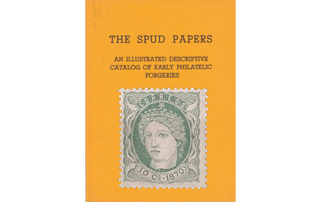
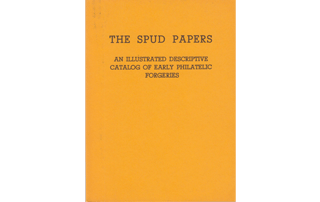
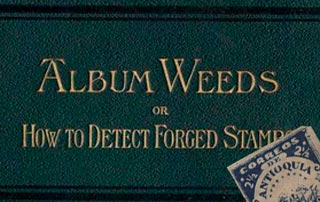
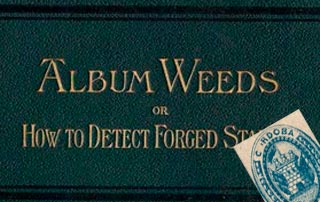

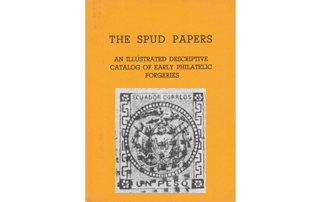
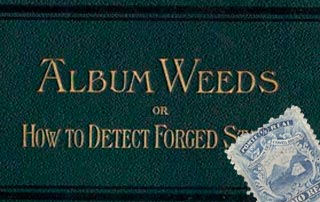
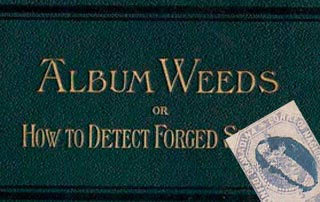
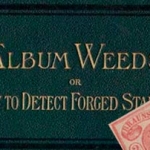
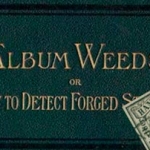
Leave a Reply
Want to join the discussion?Feel free to contribute!